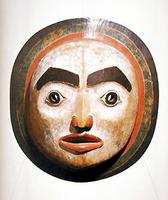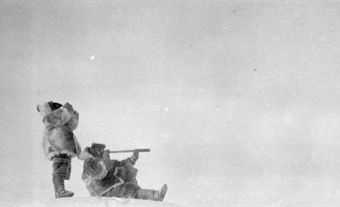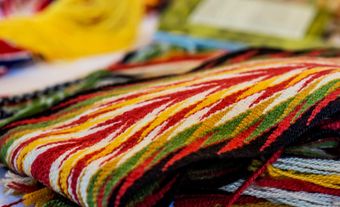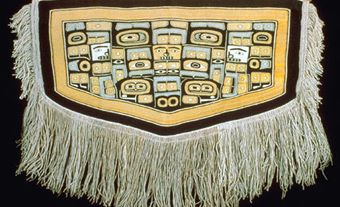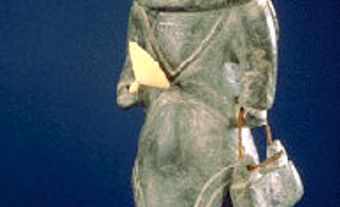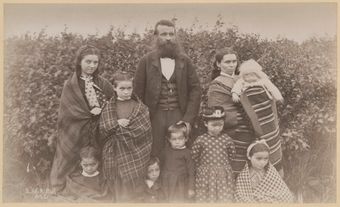Indigenous Art in Canada
The history of Indigenous art in Canada begins sometime during the last Ice Age between 80,000 and 12,000 years ago (see Prehistory). To date, however, the oldest surviving artworks (excluding finely crafted, aesthetically significant stone tools) are datable to no earlier than 5,000 years ago. Decorative and depictive carvings from the earliest periods have been found in the Lower Fraser region of British Columbia, and other pieces have been found in several parts of Canada. The development of Indigenous art in Canada is in many ways more complex than that of the relatively recent European settlers, and may be divided into three distinct periods: prehistoric art, contact or "historic" art, and contemporary Indigenous art.
While historians of First Nations and Inuit art rely to a large extent upon archaeological finds in the study of the prehistoric period, the work of ethnographers, ethno-historians, and historical archaeologists who study the history and evolution of Indigenous cultures through the analysis of documents, maps, and a variety of material artifacts, is of vital importance for knowledge of historic Indigenous art. These scholars have sought to place the interpretation of the function and meaning of Indigenous artworks in the context of a broader understanding of the ways of life, aesthetic values, and principles of the peoples themselves.
Ethno-historians have examined early visual sources and written documents such as maps, paintings, captains' logs, and accounts by explorers, traders and travellers. From these fragments, historians have traced the history of Indigenous peoples in Canada from initial contact to the 21st century. Historical archaeologists have excavated post- contact sites that provide a precise chronology for the interaction between Indigenous and European peoples. Historical archaeologists also give evidence of the introduction of new materials, techniques and working methods to Indigenous artists and craftspeople.
Prehistoric Art
Prehistoric art is the period of Indigenous art least known in Canada; its end date varies from region to region. While contact with French settlers in the Maritimes and St. Lawrence Valley took place in the 16th century, the First Peoples of the West Coast did not see Europeans until the late 18th century.
Prehistoric art varies not only in genre, style, function, imagery, and meaning from region to region, but has undergone significant changes from period to period. These changes accelerated almost everywhere in Canada after about 1000 BCE as a result of the introduction of agriculture and settled village life from the eastern woodlands of the United States and ultimately from Mexico, where New World civilizations developed independently from those of the Old World.
There are several outstanding examples of prehistoric art in Canada. The Marpole culture (500 BCE to 500 CE), which was centred on the Fraser River delta and the surrounding Gulf Islands of the southern British Columbia coast, produced a variety of stone and bone carvings (ceremonial bowls, effigies and utensils) that anticipate the style and iconography of post-contact Northwest Coast Indigenous Art.
Pre-contact Iroquoian culture (900–1600 CE) in southern Ontario (the Iroquoian language group included Huron, Petun, and Neutral peoples) produced pottery of high technical quality and visually pleasing effects, decorated with both representational and geometric designs. Iroquoian art in the Upper St. Lawrence Valley is noted for its clay and stone effigy pipes that exhibit a variety of shapes and iconographies. Both pipe bowls and stems were carved or modelled in high relief and incised with human forms and images of lizards, turtles and birds, all important power animals in the iconography of Great Lakes religious art. These tiny masterpieces had a sacred function, the ritual smoking of tobacco in the context of First Nations spiritual beliefs.
Discovery, knowledge and relative dating of prehistoric works of art depend upon meticulous excavation and careful interpretation. Important discoveries include a diminutive but sophisticated carved human figure from the Glenrose site near the mouth of the Lower Fraser River in British Columbia. This tiny antler figurine, which may have served as the handle of a carving tool, dates to approximately 4,000 years ago and already gives evidence of formal characteristics typical of historic period art from the Northwest Coast.
Other discoveries include the location in northwest Ontario of what may be Canada's oldest artwork, a petroglyph site perhaps 5,000 years old; a carving of a smiling human head, 5000–3000 BCE, from the Coteau-du-Lac site on the St. Lawrence River in southwest Québec; and the verification that the spectacular art forms of coastal British Columbia — most notably totem poles — are not the product of European contact as formerly believed, but have a continuous on-site development dating back at least 2,500 years. Since the moist, acidic soils of much of Canada's northland do not permit the survival of artworks in wood, fibre, hide or other perishable materials, much of Canada's prehistoric art has been lost. One major exception has been rock art: paintings in red ochre and carvings incised, or cut upon natural rock surfaces, have survived (see Pictographs and Petroglyphs).
Post-contact Art
Post-contact or "historic" art in Canada is well known, mainly because examples have been collected, sketched and written about by explorers, traders, missionaries, artists and scholars for over 300 years and are part of museum collections around the world. The various regions into which Indigenous art is customarily divided are based upon the distribution and cultural characteristics of Indigenous groups in the early contact period, but this emphasis has resulted in a frozen time perspective and an erroneously narrow view of the great historical depth, diversity, and richness of First Peoples art history.
Post-contact Indigenous art in Canada may be divided into seven regional subdivisions: Eastern Subarctic (eastern Canadian Shield); Western Subarctic (western Canadian Shield and Mackenzie drainage area); Southern Great Lakes and Upper St. Lawrence Valley; Prairies (southern Manitoba, Saskatchewan and Alberta); Plateau (interior southern British Columbia); Northwest Coast (BC coast); and Arctic (arctic coastline and offshore islands eastward to Newfoundland).
Eastern Subarctic
Set in the eastern Canadian Shield, which covers northern Québec all the way to Labrador and extends down Hudson Bay to James Bay, the art of the Eastern Subarctic may be the most ancient in Canada, the majority of prehistoric and early contact rock art sites being located in this region. The largely Algonquian-speaking peoples — the Ojibwa, Cree, Algonquin, Ottawa, Innu, and the Mi’kmaq and Maliseet of the southern Maritimes — continued a nomadic way of life based on hunting, fishing and the gathering of wild foods well into the 19th and even 20th centuries.
The art of the Mi’kmaq and Maliseet of Nova Scotia and New Brunswick remained distinctive well into the 20th century. The Mi’kmaq are noted for their moose hair embroidery and porcupine quillwork on birchbark and basketry, as well as hide and textile clothing. The glass beads introduced by European traders were welcomed early on by Mi’kmaq and other Indigenous women artists as substitutes for quills and moosehair, which are more difficult to work with.
The use of beads, with their richness of colour and diversity of size and transparency, inevitably changed the aesthetic character of Mi'kmaq design. Mi'kmaq women's art in quills, moosehair and beads was largely two-dimensional, secular in function and abstract in style, in contrast to that produced by men, who worked in three dimensions with harder and more resistant materials such as wood and stone.
A well-known characteristic of Mi'kmaq design is the so-called "double-curve" motif, a symmetrical arrangement of two opposing spirals or curves that is suggestive of plant forms. It appears as the basic, underlying pattern in much two-dimensional design throughout the Eastern Subarctic and becomes highly elaborate among the central Algonquians and Iroquoians of the Great Lakes area. Although this may have been influenced by young Indigenous girls taught needlework by Ursuline nuns, the pattern was rooted in an existing culture, for plants and their medicinal properties played an important role in subarctic Indigenous religious belief and in their shamanistic healing practices.
The art of the nomadic Innu is also remarkable for its two-dimensional design. Especially noteworthy are caribou hide coats incised and painted with linear geometric patterns and with the double-curve motif. Throughout the subarctic and Great Lakes areas, the colour red plays an important symbolic role, expressive of life's renewal and the continuity of the life force in both animals and men.
The Ojibwa of subarctic Ontario and Manitoba are noted for many distinctive art forms. The artwork of Ojibwa women was similar in technique, function and genre to much of that produced throughout the subarctic area: quillwork and beadwork on clothing, bark and basketry in both geometric and floral patterns. Ojibwa men, responsible for sacred works with a ceremonial function, produced an art that was largely symbolic, representational and documentary. Sacred art was intended to embody specific meanings, to portray spirit helpers and record ritual and mythological events and experiences.
This division of artistic labour appears to have been the general pattern throughout North America: men producing public art for religious and ceremonial purposes, women producing personal art, largely for the sake of sheer visual pleasure but often using motifs symbolizing spiritual and cosmological concepts such as the Four Quarters or the zigzag lightning of thunderbird. Ojibwa medicine men (or Shamans) were responsible for much of the rock art produced in Ontario and Manitoba, recording their visionary spirit encounters well into the 20th century.
One of the most important forms of Ojibwa religious art in the historic period was the sacred birchbark record — rectangular pieces of bark measuring from several centimetres to over 3 m in length that were carved in an almost imperceptible, fine-line technique with highly esoteric and symbolic images. These records served as documents of sacred lore or as memory aids for ritual, and the most detailed, extensive and valued were those produced by the Midewiwin or Grand Medicine Society, a closed male society whose initiation rituals were recorded with line drawings on birchbark scrolls.
Among the least studied has been the art of the subarctic Cree. Aesthetic expression among the Cree is highlighted by exquisite quillwork and moosehair embroidery, noted for its perfection of technique and delicate colour harmonies. As nomadic hunters living a precarious existence in a harsh climate from east of James Bay to northern Saskatchewan and Alberta, the Cree had to carry their goods on their person. Thus, items of clothing, especially painted and embroidered coats, moccasins and mitts, became a focus for personal aesthetic expression. Such sacred art as shamans' painted drums and ceremonial animal hides executed with symbolic motifs, are lesser known but equally important as aesthetic objects among both Cree and Ojibwa.
Western Subarctic
From the Pacific Ocean inland to the central region, the vast Western Subarctic is largely populated by Athapaskan speaking peoples. The Athapaskan speaking Dene Nation share a similar culture and art with their Eastern Subarctic neighbours, the Cree, Iroquois, and Ojibwa. Decoration of personal gear and clothing was the major form of artistic expression: caribou and moose hide were embellished with porcupine quills, moosehair embroidery, beads and commercial threads in geometric and floral patterns. Compared to southerly groups, such as the Ojibwa and Iroquois, the subarctic peoples revealed in their embroidery their delicate colour sense and exquisite precision in design.
Southern Great Lakes and Upper St. Lawrence Valley
From the late prehistoric to the early historic period, the Iroquoian-speaking peoples of this region — the Huron, Neutral, Petun and later the Iroquois proper — underwent more rapid changes than Indigenous peoples in any other region in Canada. Because they were farmers, living in relatively permanent villages, their political and social institutions found expression in suitable works of art. By the 19th century, however, many of the First Nations had migrated westward or eastward, or were re-settled in reserves throughout the area. Art came to have a new purpose, as a commodity for sale to outsiders — to tourists and collectors of Indigenous arts and crafts.
In prehistoric times this region was already subject to outside influences. For instance, the Iroquois had trade connections to the south with the highly complex and economically advanced "Mississippian" cultures of the eastern woodlands. Mississippian cultures, in turn, were stimulated by Mexican cultural innovations (ceramic technology entered Canada this way). In the early contact period, they made alliances with Europeans through the fur trade.
The history of art in this region is too complex to detail, except for a few highlights. While there is considerable homogeneity in quillwork and beadwork throughout the subarctic and Great Lakes area, Huron work is distinctive in the later historic period. Huron "personal art" favoured moosehair embroidery in floral motifs of exquisite beauty on black dyed hide.
The quality of trade goods had peaked by 1830, long after the Huron had left western Ontario to settle at Lorette, Québec. Hide and yarn shoulder pouches and bags, executed with a wide variety of geometric, naturalistic and mythological motifs, were the predecessors of the more recent loom-woven and heavily beaded "Bandolier" bags of the western Great Lakes area. The most common motifs were Thunderbird and the Underwater Panther, finely rendered in quills, moosehair and beads.
Typical as well were finger-woven sashes interwoven with white beads, burden straps of twined hemp, wooden ball-headed clubs carved in high relief and elaborately decorated knife sheaths. The noted Assomption Sash was a trade item. However, as with silver work, Indigenous peoples adopted European techniques and designs. Even the splint baskets, prized by collectors as a typical indigenous craft, employed a technique learned from Swedish settlers in the Delaware Valley.
The Iroquois proper, also known as the Haudenosaunee or the Six Nations, did not settle in Canada until after the American Revolution ended in 1783. The most noteworthy art forms of the historic Iroquois are the False Faces, wooden masks with metal eyes and sometimes horsehair, which were carved by men for use in curing ceremonies (see False Face Society). Strongly sculptural in character, with a variety of mouth types and painted in red or black or both, they are sacred objects believed to contain the life force of the living tree.
The masks represent mythological beings, the most notable being "Crooked Face," the one who challenged the Creator and had his nose broken. Other masks, plaited from dried corn husks, were worn in agricultural ceremonies and represent a second group of earth-oriented supernatural beings, those who taught mankind how to grow crops.
In addition to personal art (clothing) and sacred art (False Faces), the Iroquois produced another kind of art object that continues to hold political function and meaning. Wampum strings and belts of several centimetres width and sometimes metres in length were made of purple and white shells traded in from the Atlantic coast. In the absence of writing, yet with a high degree of political sophistication, wampum belts served as a visual record of treaties and events. As such, the wampum belt became a symbol of friendship and cooperation between political groups, both First Nations and European.
Prairies
Situated in the sweeping grasslands of Saskatchewan, Manitoba, Alberta, and parts of British Columbia, Prairie Indigenous culture as it emerged in the 19th century was a synthesis of Indigenous and white cultures, the product of post-contact European influences such as the horse and the gun, which provided increased mobility and effectiveness in the buffalo hunt. The art produced by the Blood, Blackfoot and Assiniboine is similar to that of their eastern subarctic and western Great Lakes neighbours in techniques, materials and motifs, as westward migration, the consequence of new hunting opportunities, the fur trade and advancing European settlement, brought eastern influences into prairie culture.
The art produced by Prairie peoples was for the most part two-dimensional, in which painting on hides was the major genre. Large tipis that required the hides of up to 40 buffalo were their most prominent architectural form. Among the Blackfoot of southern Alberta, tipis of important men were often lavishly painted with naturalistic and geometric motifs. Dream images depicted on rawhide shields rival contemporary surrealist paintings in visionary and aesthetic impact. As images of the warrior's personal guardian spirits, they were believed to protect him in warfare and help in the hunt. Painted buffalo robes were another major art form, with motifs ranging from the abstract, concentric sunburst pattern to representational images.
Personal art was the focus of aesthetic attention, as deer hide moccasins, jackets, dresses, leggings and shirts were embellished with porcupine quillwork and beads. Painted parfleches, rawhide containers of various shapes and sizes, were unique to this area, and no design was exactly the same as another.
Plateau
Set in the area between the British Columbia coastal mountains and the Rocky Mountains, the plateau region is often ignored in surveys of Indigenous art but is unique in many ways. The interior Salish left behind a major body of prehistoric pictographs. The Lillooet, Thompson, Okanagan and Shuswap of the historic period are noted for their finely crafted, watertight baskets made by a coiling technique and decorated with geometric motifs. Little research has been done on the art of the plateau peoples, on their blankets woven of mountain goat wool, their clothing, or the religious beliefs that provide the context for art interpretation in many First Nations cultures.
Northwest Coast and Arctic
The historic art of the Northwest Coast and of the Arctic has been the subject of considerable attention in recent years. (For more detailed accounts of these two artistic traditions, see Northwest Coast Indigenous Art, Inuit Art, and Inuit Printmaking.)

 Share on Facebook
Share on Facebook Share on X
Share on X Share by Email
Share by Email Share on Google Classroom
Share on Google Classroom


